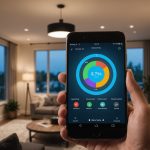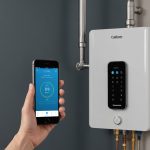Overview of Smartphone Technology in Senior Care
Smartphone technology plays a pivotal role in modern caregiving, providing innovative solutions that cater to the needs of seniors and their caregivers. Smartphone integration in senior care has transformed how health management is approached, offering essential features that enhance the overall caregiving experience.
Seniors benefit from smartphones through applications designed for medication management, health monitoring, and communicating effectively with family and caregivers. These devices offer user-friendly interfaces that are particularly advantageous for those less accustomed to technology.
This might interest you : Harnessing Voice Technology: Your Comprehensive Guide to Smart Home Lighting Management
In recent years, emerging trends have focused on smartphone applications tailored for health management, such as telehealth services and integrated wearables. These advancements allow for real-time health data collection and monitoring, improving the quality of senior care. Caregivers can now monitor vital signs, activity levels, and medication adherence remotely, ensuring the well-being of their loved ones.
The increasing adoption of smartphone technology in senior care encourages continuous innovation. Developers are focusing on enhancing application accessibility and functionality, aiming to address unique challenges faced by seniors. With the potential for ongoing advancements, smartphone technology will likely continue playing a crucial role in shaping the future of senior care.
Also to see : Master Your Smart Home: Effortlessly Command Your Water Heater from Your Smartphone
Essential Applications for Senior Care Management
The integration of senior care apps has revolutionized how caregivers support and engage with seniors. These applications are pivotal in ensuring both the well-being and independence of older individuals.
Health Monitoring Applications
Health tracking apps are vital in modern senior care, offering caregivers real-time access to essential health data. Applications like Apple Health and Fitbit allow for continuous monitoring of vital signs, sleep patterns, and activity levels. By consolidating this data, caregivers can make informed decisions about a senior’s care plan. Reviews frequently highlight the reassurance families feel when able to monitor loved ones remotely. Case studies reveal how data-driven decisions, facilitated by such apps, dramatically improve senior care quality.
Medication Management Tools
Ensuring medication adherence is crucial for effective senior care. Medication reminder apps like Medisafe and MyTherapy are designed to prevent missed doses by providing timely alerts and tracking intake. Features often include interaction warnings and refill reminders, promoting independence and safety. Real-life stories underscore their impact, highlighting scenarios where users experienced improved health outcomes due to consistent medication adherence.
Communication and Connectivity Tools
With an array of communication apps available, maintaining contact between caregivers and seniors is seamless. Tools such as WhatsApp and Skype foster social engagement, crucial for seniors’ emotional well-being. Case studies frequently emphasize how these technologies have bridged geographic distances, enhancing the quality of life for all involved in senior care.
Home Management Features That Enhance Senior Living
The integration of home management technology offers significant benefits in senior care, enhancing both safety and convenience. Smart home solutions present a pivotal advancement, specifically designed with user-friendly interfaces to cater to seniors’ needs. These technologies are instrumental in encouraging independence while ensuring peace of mind for caregivers.
Key benefits of adopting smart home technology include enhanced safety features such as automated lighting, voice-activated devices, and fall detection systems. For instance, voice assistants like Amazon Alexa and Google Home allow seniors to perform daily tasks effortlessly without complex interactions. Moreover, these systems can be programmed to alert caregivers of any emergencies automatically, promoting a safer living environment.
Examples of home automation tools beneficial for caregivers include smart thermostats that regulate home temperature according to senior preferences and programmable door locks that offer remote access control. These tools not only simplify home management for caregivers but also significantly reduce risks associated with forgetfulness or physical limitations seniors might face.
By embracing smart home technology, both seniors and caregivers can enjoy a more efficient and secure living arrangement. The adaptability of these tools continues to transform senior care, providing innovative solutions that cater to their dynamic needs.
Integrating Health Monitoring Tools with Smartphones
The integration of health monitoring tools with smartphones has become increasingly significant in senior care, offering a seamless link between caregivers and essential health data. By utilising wearable technology, seniors can track vital signs and activity levels, such as heart rate and steps taken. Popular wearables like the Fitbit and Apple Watch demonstrate functionalities such as real-time health monitoring and syncing data with smartphone applications. This synchronisation allows caregivers to access comprehensive health records, making informed decisions regarding senior care more straightforward.
Wearable Devices for Seniors
Wearable devices offer numerous benefits for seniors, primarily by enhancing health tracking capabilities. Devices like the Garmin Vivosmart or the Withings Move ECG provide features such as ECG monitoring and sleep pattern analysis. These functions empower seniors to maintain an active lifestyle while ensuring caregivers stay informed about their well-being.
Remote Health Monitoring Systems
Remote health monitoring systems advance healthcare accessibility for seniors by incorporating telehealth capabilities. Through smartphone applications, users can engage in virtual consultations, enhancing medical care access irrespective of location constraints. Testimonials from users highlight increased convenience and reduced hospital visits due to these systems. Seniors report feeling more secure knowing their health is continually monitored, leading to improved peace of mind for both themselves and their caregivers.
Best Practices for Implementing Technology in Senior Care
Selecting the appropriate technology solutions is a critical step in enhancing senior care. Begin by evaluating the specific needs of both seniors and caregivers. Create a checklist of desired features, such as health monitoring or communication tools, to match solutions that best address these needs. Prioritise user-friendly interfaces and compatibility with existing caregiving infrastructures to ensure smooth integration.
Training is equally vital for the successful deployment of technology in senior care. Caregivers should undergo comprehensive training sessions to become adept at using new devices and applications. A focus on improving the technical proficiency of seniors, through guided tutorials or literacy programs, can promote independence and ease in adopting modern solutions.
Overcoming resistance to technology is a common challenge. Address potential concerns by reinforcing the benefits and engaging caregivers and seniors in the selection process. Encourage feedback and incorporate their suggestions to make them feel valued. Highlight personal success stories from peers to illustrate positive outcomes, fostering enthusiasm for embracing innovation.
By adhering to these best practices, senior care providers can effectively implement technology solutions, ultimately enhancing the quality of life for seniors under their care.
Real-World Case Studies in Senior Care Technology
Exploring real-world case studies in senior care technology reveals how digital innovations have transformed caregiving practices. These success stories illustrate the practical impact of technology on enhancing caregiver efficiency and senior well-being.
One notable example involves smart home solutions reducing emergency incidents. A senior care facility implemented automated lighting and voice-activated gadgets to improve accessibility and safety. The outcome was significant, with a reported decrease in nighttime accidents and increased resident satisfaction. Such stories underscore technology’s role in promoting senior independence.
In another instance, using health integration with wearables like Apple Watch allowed for consistent health monitoring. A user’s irregular heart patterns were detected early, prompting timely medical intervention. This case highlights the critical role of wearable technology in preemptive health care.
Additionally, a telehealth service case study demonstrated that seniors participating in virtual consultations noted improved convenience and healthcare access. Participants reported feeling more connected to their healthcare providers, reducing anxiety and travel challenges.
These examples not only show the technology’s potential to enhance caregiver support but also emphasize the importance of adapting and implementing innovative solutions to improve senior care outcomes.











